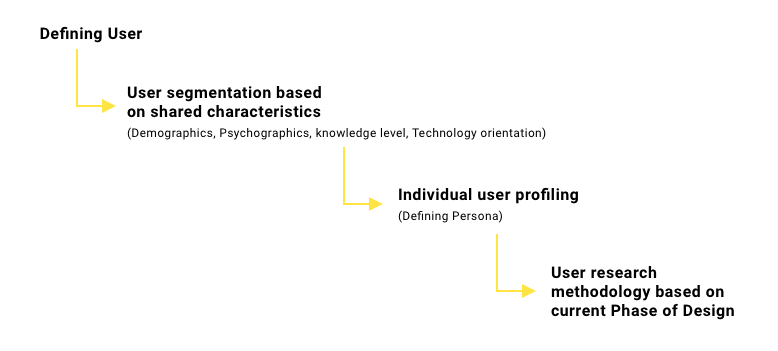User Research is gathering data via actual interactions with the user. Based on these data and insights, we can build Useful and User-centered experiences.
The goal of designer is to listen, observe, understand, empathize, synthesize, and glean insights that enable him or her to make the invisible visible
– Hillman curtis
Why do we do user research?
User research helps us,
- Discover people’s real need and behavior patterns
- Make informed decisions about your product
- Avoid usability issues that need fixing later
- See how diverse users approach every problem differently
- See WHAT the problem is, WHY it is a problem, and guide us on HOW to fix it
The definition of Utility is ‘whether it provides the features you need’ and Usability is ‘how easy and pleasant are these features to use.’ Usefulness combines both Utility and Usability. User Research helps build a product that is more useful and makes informed decisions about your product design.
The basic flow of user research study
Without any understanding of your users, you cannot design a successful and sustainable product. You either create a solution that doesn’t solve the right problem or a solution that doesn’t solve the problem adequately. User research must be done, keeping in mind user goals.
However, there are numerous methods for user research, and the basic flow is relatively typical:

Research Toolkit
Interviews
User interviews are where a researcher asks questions and records responses from users. They can be used to examine user experience, the usability of the product, or to flesh out demographic or ethnographic data (as inputs for defining user personas).
Designing a good questionnaire is one of the most critical aspects of conducting useful user research.
- Structure your questionnaire based on the goal of the study
- Ask open-ended and close-ended questions depending upon the kind of responses you need for the study
Closed-ended questions encourage short and specific answers, often Yes/No type of solutions. For example,
Q: How often do you cook?
A: Thrice a week
Open-ended questions, on the other hand, encourage full and meaningful answers from the subject involving their feelings, behavior, and knowledge. For example,
Q: What are your thoughts on cooking?
A: I love cooking and try to discover and try new recipes all the time!
User interviews are an inexpensive and easy way to get data “straight from the horse’s mouth.” However, it’s essential to bear in mind that there are limitations to this technique, and you may discover that people often say and do different things. Conducting interviews is simple. Write a script and go through it with the user. Make sure to keep the user informed and comfortable as you do.
Observation in the wild
This is also called shadowing or passive observation. Observation in the wild includes market research, observing scenarios, and behavioral patterns of users. Remember, never take pictures/videos without explicit permission from the user.
Surveys
Conduct surveys to gather high-level usage trends and behavior data from large groups of people. A survey may not be a suitable method while trying to understand how and why people carry out certain actions. Surveys are useful when high-level questions need to be answered by a large group of people. Keep your survey small (approx 5-7 questions) and questions short. Be very specific about items in your study.
Remember to ask,
- How often they use the product or do a specific activity
- What issues (if any) they have encountered
- Rate how easy is it to use
- Let them explain their ratings
Cognitive walkthrough
A cognitive walkthrough is gathering users’ reactions to a product or a concept. This is the process of interviewing individuals and not a group. Give users a set of tasks to perform and note down their reactions.
Remember to,
- Use a prototype (a non-functional or semi-functional prototype is okay)
- Probe to understand the reactions, expectations, and questions of the user
- Assist with a prototype as necessary
Usability testing
This testing shows how easy (or not) is to use a product for the user
Remember to,
- Use working prototypes.
- Measure behaviors (i.e., task completion Yes/No)
- Assist users only when necessary
Choosing a research method based on a design phase
User research methods need to be selected based on the Design phase to simplify the design process.

Research ethics and its importance in an organization
Research ethics is the careful consideration of the rights, well-being, and dignity of people involved in the research activity. Careful consideration and empathy form a big part of Research conducted with vulnerable people and sensitive topics. Ethically mature organizations have,
- Research ethics training for researchers
- Guidance documents
- Standardized consent forms and information sheets
- Ethics experts
- Data protection policies
Conclusion
The aim of user research methods is to gather necessary data and solve problems at various design phases resulting in an enriched user experience. An organization needs to follow user research ethics as it makes your research more effective and efficient.
References
- Bowman, Nicholas, and Nicholas Bowman. “The Ethics of UX Research: UX Booth.” UX Booth The Ethics of UX Research Comments. Accessed March 11, 2020. https://www.uxbooth.com/articles/ethics-ux-research/.
- “Keeping Research Lean in the Agile World of UX.” Inside Design Blog. Accessed March 11, 2020. https://www.invisionapp.com/inside-design/keeping-ux-research-lean/.
- McCormick, Jennifer. “Free Research Methods Tutorial – Beyond Usability: Learn the User Research Toolkit.” Udemy. Udemy. Accessed March 11, 2020. .
- Tawak, Lade. “Things Nobody Tells You About Being a UX Researcher.” Medium. UX Collective, December 12, 2019. https://uxdesign.cc/ethics-of-ux-research-f2399a7ec967.
- World Leaders in Research-Based User Experience. “When to Use Which User-Experience Research Methods.” Nielsen Norman Group. Accessed March 11, 2020. https://www.nngroup.com/articles/which-ux-research-methods/.
- World Leaders in Research-Based User Experience. “Ethical Maturity in User Research.” Nielsen Norman Group. Accessed March 11, 2020. https://www.nngroup.com/articles/user-research-ethics/.
- Read, A., Ben Aston, June 12, 2., Also, S., Read, 5., & Views, 1. (2020, June 12). 15 Statistics You Should Know About A Career In UX Design. Retrieved July 16, 2020, from https://thecxlead.com/topics/statistics-about-career-in-ux-design/.
If you enjoyed reading this post, here are a few more that may interest you,














